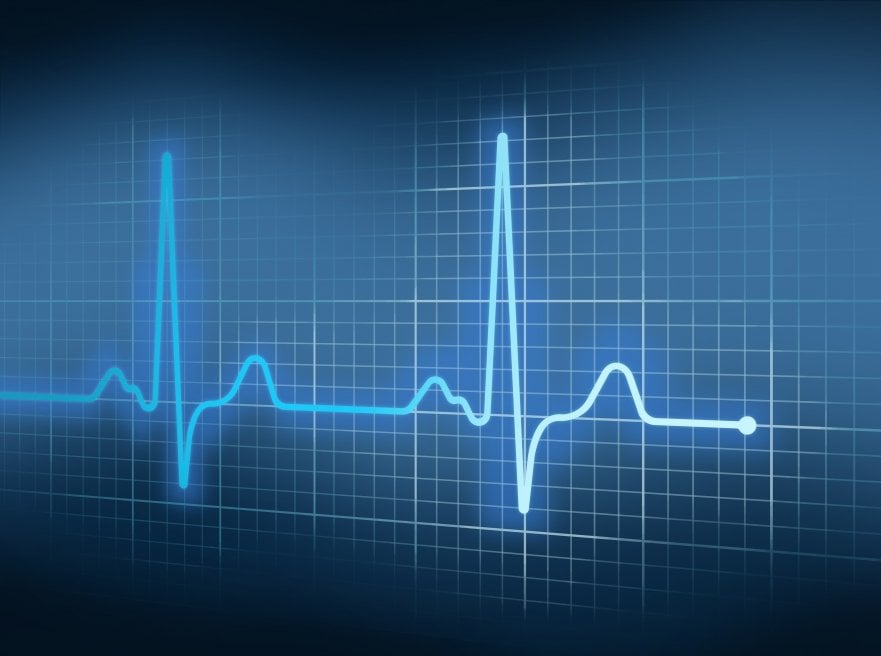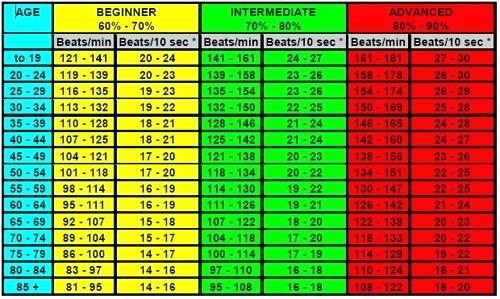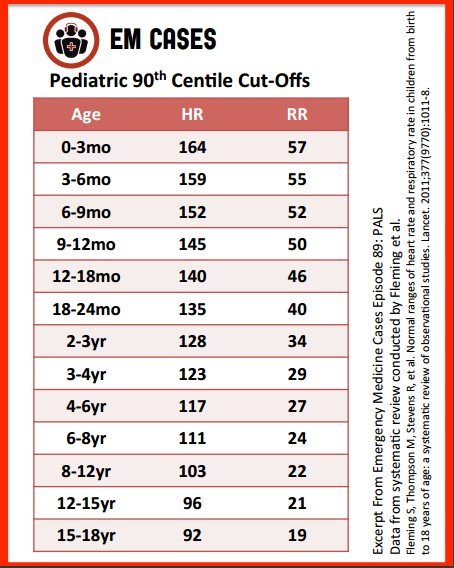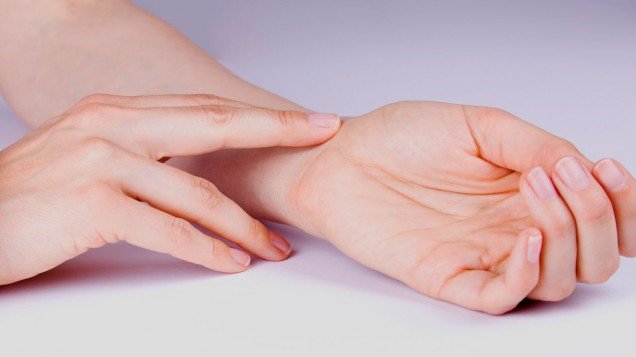The pulse or heart rate can be checked at areas where an artery passes close to the skin. You can measure your pulse or heart rate using your index finger or using stethoscope.
Here are some information how to check heart rate accurately.
Why Should I Check My Heart Rate?
The heart rate is one of the ‘important signs,’ or the indicators of health in the human body. It measures the number of times per minute that the heart contracts or beats. The speed of the heartbeat tells the health of your heart. Ideally your heart beat should be 60 to 80 per minute but it may vary due to physical activity, threats to safety, and emotional responses.
Difference Between Heart Rate and Pulse:
Heart Rate:
The heart is a muscular pump that with each heart beat pumps blood around the body. On leaving the heart the blood first travels along the arteries. The heart rate is the number of times the heart beats in the space of a minute.
Pulse:
The pulse is what you feel over an artery as the pressure inside increases following each heart beat.

Factors That Affects your Heart Rate
Age:
At different age Heart is different.
Fitness and activity levels:
After doing exercise or any physical activity your rate may increase
Being a smoker:
Smoking increases heart rate, tightens major arteries, and can cause an irregular heart rhythm.
Having cardiovascular disease, high cholesterol or diabetes:
These cardiac diseases may increase your heart rate.
Temperature:
Warmer temperatures cause the heart to beat faster and place considerable strain on the body.
Body position (standing up or lying down):
For healthy individuals, your heart rate will be the same whether you are sitting, standing, or lying down. However, when you first transition between sitting and standing, you heart rate increases slightly (about 10 bpm). If you’ve even stood up really fast and then felt dizzy or couldn’t see, that’s what happening. This only lasts for a moment (10-20 seconds) and then your heart rate returns to normal.
Emotions:
Heart is a symbol of our emotions too. Any changes in emotions directly affects our heart. Emotions like grief, depression, and job loss can cause to heart attack and cardiac arrest. Stress may affect risk factors for heart disease such as high blood pressure.
Body size and Height:
The blood pressure and heart rate increased with increasing height in males but both reduced with increasing height in females.
Medications:
Many medicines are available that can lower and faster your heart beat.
Areas in body where we can check Pulses:
1) Temporal Artery
It is located just above the temple, on the sides of the head.
2) Carotid Artery
It is located on the side of the neck above the clavicle.
3) Brachial Artery
It is located on the inside of the arm above the elbow. Look at the arrow mark in the above figure. There is an artery that goes towards the side of our hands, that is the Brachial artery
4) Radial Artery
This artery is clearly visible on the wrist. Press this artery lightly with flat fingers.
5) Femoral Artery
This artery is located , in the inside front of the leg where it joins the pelvic.
6) Posterior Tibial Artery
It is located on the foot behind the ankles.
7) Dorsalis Pedis Artery
It is located on the top of the foot.
How to check Pulse and Heart Rate:
Before measuring the heartbeat you must keep resting for at-least 10 minutes. then you can start examining your pulse following below steps:
- Place your index and middle finger of your hand on the inner wrist of the other arm, just below the base of the thumb. You should feel a tapping or pulsing against your fingers.
- To measure the pulse on the neck, place the index and middle fingers just to the side of the Adam’s apple, in the soft, hollow area. Press gently until you locate the pulse.
- Once you find the pulse, Count the number of taps you feel in 10 seconds and multiply that number by 6 to find out your heart rate for 1 minute. Or you can count the beats for 1 full minute, Or, count the beats for 30 seconds and multiply by 2.
Besides checking your pulse, your doctor can hear the opening and closing of your heart valves by using a stethoscope.
Check Heart Rate Using Stethoscope:
In some people’s pulses are just more difficult to take by palpation (pressure on an artery with the fingers) than others. If you have been advised by your physician to monitor your heart rate regularly and are having difficulty taking your pulse this way, it will likely be easier to take it with a stethoscope instead.
1. Take a stethoscope and a watch to keep count on time.
2. Listening to your heart through your chest using Stethoscope.
3. Place the earpieces of the stethoscope in your ear.
4. Place the chest-piece the other end of stethoscope on your chest.
5. With the earpieces in your ears, GENTLY rub the diaphragm side (the one with the flat plastic piece) of the stethoscope and listen for a sound.
6. To position the chest-piece on your chest, find the imaginary line between your nipples.
7. When we listen to the heart, remember that it has TWO beats, which represent the succession of valves in your heart contracting to pump blood (lub-dub lub-dub).
HOWEVER ONLY ONE OF THOSE BEATS IS COUNTED IN YOUR PULSE. The first beat is usually stronger and I recommend listening only to that beat and tuning the first one out.
8. Look at the second hand on your watch/clock, and when the second hand hits one of the 5 minute markers start counting the beats through your scope.
9. If you counted for an entire minute you are all set and have your pulse, but in most cases we now need to do a little math because pulse values are expressed in beats per minute (BPM).
Heart Rate in Infants or Adults:
Newborns 0 to 1 month old: 70 to 190 beats per minute
Infants 1 to 11 months old: 80 to 160 beats per minute
Children 1 to 2 years old: 80 to 130 beats per minute
Children 3 to 4 years old: 80 to 120 beats per minute
Children 5 to 6 years old: 75 to 115 beats per minute
Children 7 to 9 years old: 70 to 110 beats per minute
Children 10 years and older, and adults (including seniors): 60 to 100 beats per minute.
Well-trained athletes: 40 to 60 beats per minute
What if your Heart beat is Faster or Lower than Normal?
Fast Heart Beat (Tachycardia)
Do you know your heart may beat up to 400 times per minute? Tachycardia is a fast or irregular heart rhythm, usually more than 100 beats per minute and as many as 400 beats per minute. Tachycardia can occur in either the upper heart chambers (atrial tachycardia) or lower heart chambers (ventricular tachycardia).
Causes of Fast Heart Beat
- Heart-related conditions such as high blood pressure (hypertension)
- Poor blood supply to the heart muscle due to coronary artery disease
- Atherosclerosis), heart valve disease, heart failure, heart muscle disease (cardiomyopathy), tumors, or infections
- Other medical conditions such as thyroid disease, certain lung diseases, electrolyte imbalance, and alcohol or drug abuse
- Emotional stress or drinking large amounts of alcoholic or caffeinated beverages
Symptoms of tachycardia include:
Shortness of breath
Dizziness
Sudden weakness
Fluttering in the chest
Lightheadedness
Fainting
Certain conditions can increase your risk of developing tachycardia:
Coronary artery disease (atherosclerosis)
Heart failure (poor pumping heart)
Heart attack (myocardial infarction)
Congenital heart defects (condition you are born with)
Inflammatory or degenerative heart conditions
Chronic lung disease
The good news is that not all cases of fast heartbeat mean you have a heart condition. Sometimes the palpitations are caused by things that make your heart work harder, like stress, illness, dehydration, or exercise.
Slow Heart Beat (Bradycardia)
If your heart beats less than 60 times a minute, it is slower than normal.
A slow heart rate can be normal and healthy. Or it could be a sign of a problem with the heart’s electrical system. For some people, a slow heart rate does not cause any problems. It can be a sign of being very fit. Healthy young adults and athletes often have heart rates of less than 60 beats a minute.
Men and women age 65 and older are most likely to develop a slow heart rate that needs treatment. As a person ages, the electrical system of the heart often doesn’t function normally.
Causes of Slower Heart Rate (bradycardia)?
A low heart rate may be a sign of an efficiently working heart. Or, if the rate becomes too slow, a low heart rate could be a sign of health complications down the road.
- Changes in the heart that are the result of aging.
- Diseases that damage the heart’s electrical system. These include coronary artery disease, heart attack and infections such as endocarditis and myocarditis.
- Conditions that can slow electrical impulses through the heart. Examples include having a low thyroid level (hypothyroidism) or an electrolyte imbalance, such as too much potassium in the blood.
- Some medicines for treating heart problems or high blood pressure, such as beta-blockers antiarrhythmics, and digoxin.
Symptoms of tachycardia include:
Feel dizzy or lightheaded.
Feel short of breath and find it harder to exercise.
Feel tired.
Have chest pain or a feeling that your heart is pounding or fluttering (palpitations).
Feel confused or have trouble concentrating.
Faint, if a slow heart rate causes a drop in blood pressure.
To compensate for a slowly beating heart, your heart muscle might try to pump harder to keep up with your body’s demand for oxygenated blood. This can lead to high blood pressure (hypertension) and even heart failure, if your heart muscle works overtime for too long a period. A low heart rate is also paired sometimes with low blood pressure, a condition known as hypotension. Low blood pressure is also a cause of syncope.
However, research suggests that bradycardia does not increase the risk of cardiovascular disease—the precursor to a heart attack. If you have bradycardia, but not other symptoms, you may not need any treatment. But if you do start to experience fainting or even frequent episodes of feeling lightheaded, or you start to experience chest pain, tell your doctor.
Heart Rate Chart By Age:

Heart Rate Chart By Age for Children:

Common questions & answers raised by people:
Where is the best place to feel a pulse?
The best places to take your pulse are at your wrist, inside the elbow, at the side of your neck or on the top of your foot, according to The American Heart Association. You can also take your pulse at your groin, on your temple or behind your knees. The pulse felt on the neck is called the carotid pulse.
What’s a dangerous heart rate?
Normal resting heart rate can vary from person to person, but for most adults, it’s between 60 and 100 beats per minute.
How do you assess pulse?
Palpation should be done using the fingertips and intensity of the pulse graded on a scale of 0 to 4 +:0 indicating no palpable pulse; 1 + indicating a faint, but detectable pulse; 2 + suggesting a slightly more diminished pulse than normal; 3 + is a normal pulse; and 4 + indicating a bounding pulse.
What is the normal heart rate for adults?
A normal resting heart rate for adults ranges from 60 to 100 beats per minute. Generally, a lower heart rate at rest implies more efficient heart function and better cardiovascular fitness. For example, a well-trained athlete might have a normal resting heart rate closer to 40 beats per minute.
What is the rate when its heart attack?
While it’s true that some areas of cardiac muscle will start to die during a heart attack because of a lack of blood, a person’s pulse may become slower (bradycardic) or faster (tachycardic), depending on the type of heart attack they’re experiencing (a normal heart rate is between 60 and 100 beats per minute).
What is normal blood pressure and heart rate?
Optimal blood pressure typically is defined as 120 mm Hg systolic — which is the pressure as your heart beats — over 80 mm Hg diastolic — which is the pressure as your heart relaxes. For your resting heart rate, the target is between 60 and 100 beats per minute (bpm).
Which pulse is the weakest?
The Pulse point with the greatest amplitude is the Common carotid artery and the pulse point with least amplitude is dorsalis pedis artery.
Dangerous rate of heart attack ?
While it’s true that some areas of cardiac muscle will start to die during a heart attack because of a lack of blood, a person’s pulse may become slower (bradycardic) or faster (tachycardic), depending on the type of heart attack they’re experiencing (a normal heart rate is between 60 and 100 beats per minute).
Hope you like the article, Share this Knowledge with others and helps others to know more about their heart and keep it healthy.
you may also like reading:
Health Benefits of Kiwi Fruit – 15 Proven & Surprising Facts !

